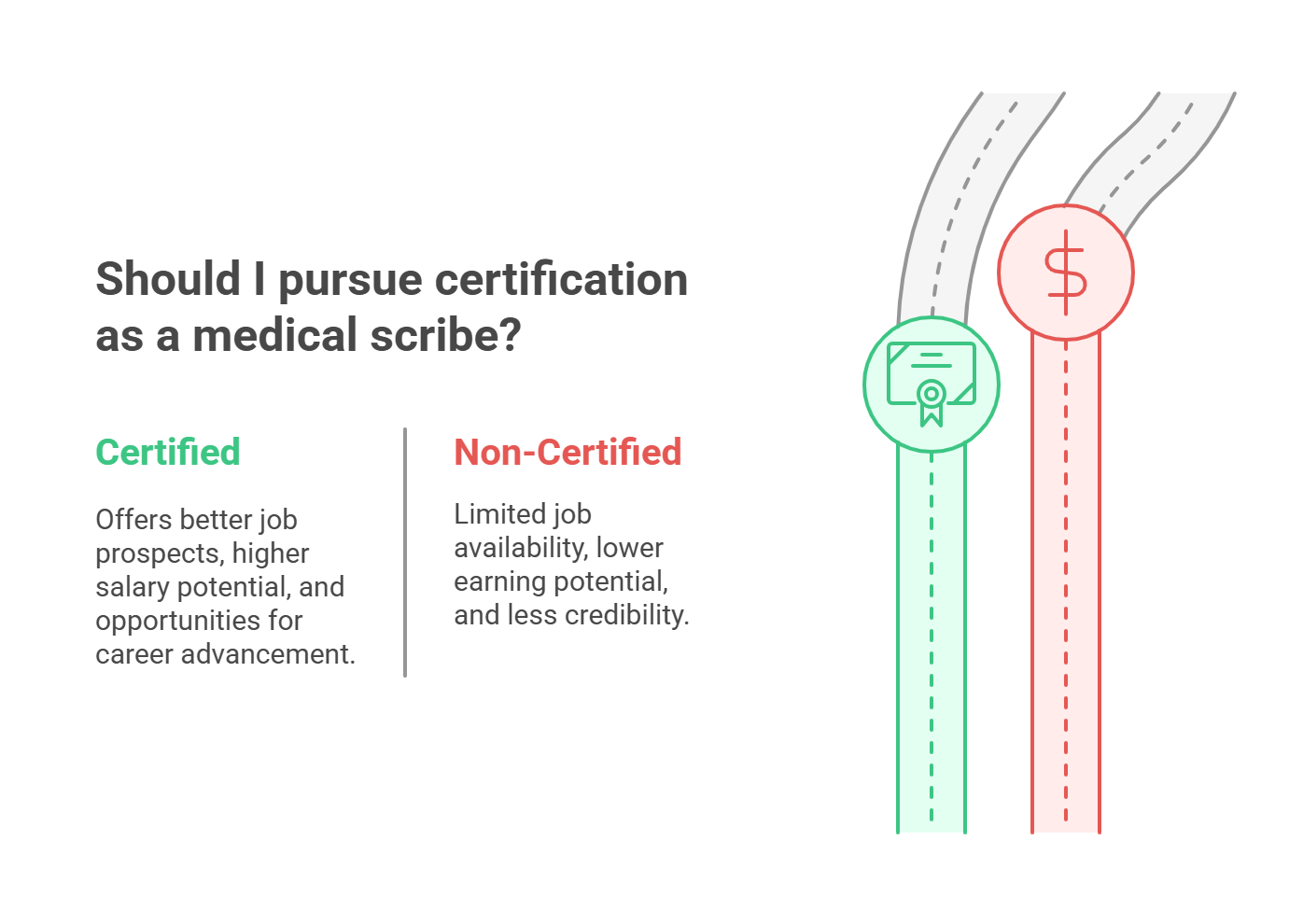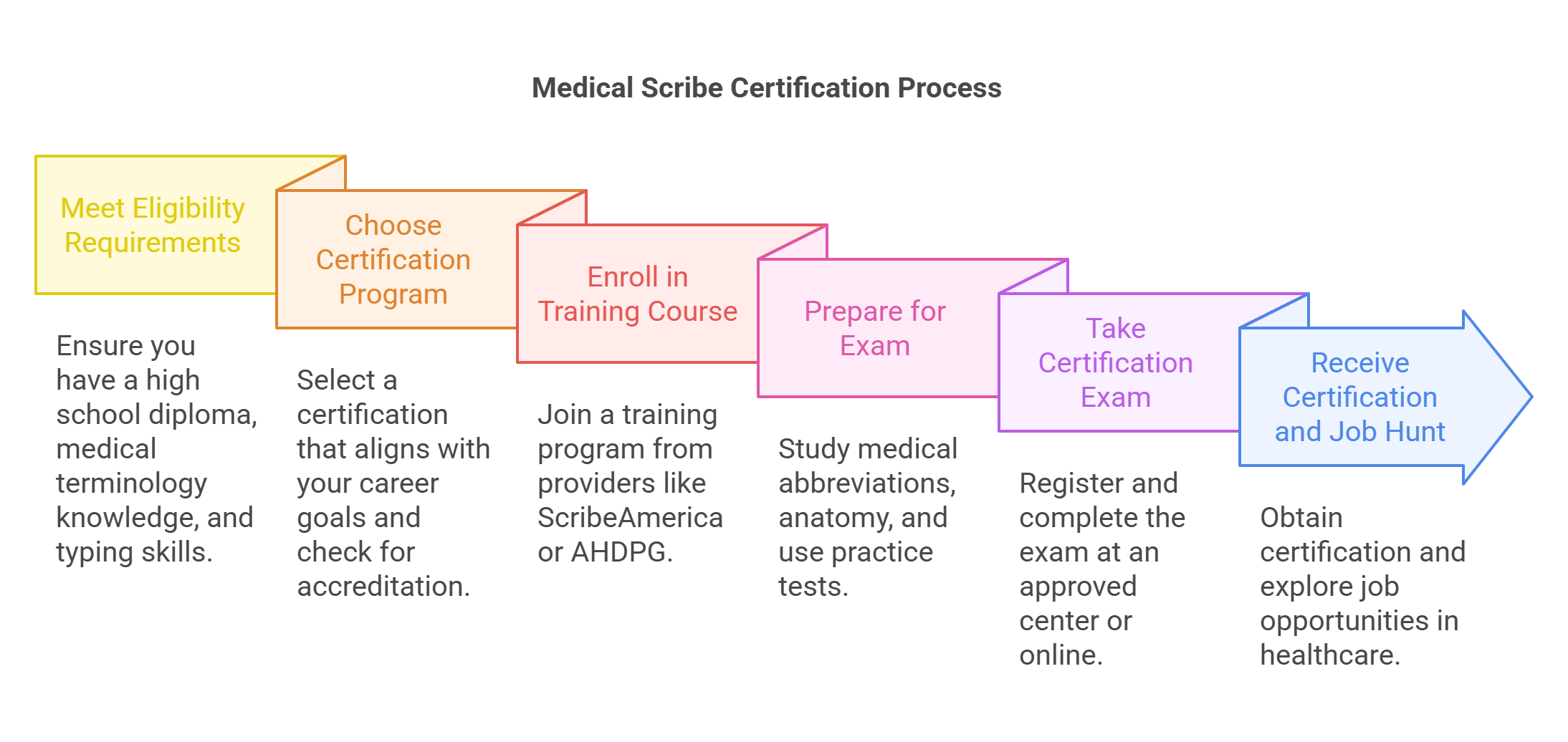How to Get Medical Scribe Certification: A Step-by-Step Guide
The healthcare industry is expanding rapidly, and medical scribes play a vital role in ensuring smooth medical documentation. If you want to become a medical scribe, getting certified can increase your job prospects, improve your salary potential, and make you stand out in the competitive job market. This step-by-step guide will walk you through everything you need to know about obtaining a medical scribe certification, from eligibility requirements to job opportunities.
What is a Medical Scribe?
A medical scribe is a trained professional who plays a crucial role in the healthcare industry by assisting physicians and other medical providers with real-time documentation of patient interactions. In modern healthcare settings, accurate and timely documentation is essential for ensuring high-quality patient care, legal compliance, and efficient workflow. However, the increasing demand for thorough medical records has also led to significant administrative burdens on doctors. This is where medical scribes step in to bridge the gap, allowing healthcare providers to concentrate on patient care rather than spending excessive time on paperwork. You can learn more about medical scribes and their role in this article.
Role and Responsibilities
Medical scribes work closely with doctors, following them during patient visits to record symptoms, diagnoses, treatment plans, and prescriptions. Their duties include:
Documenting patient history and physical exams in electronic health records (EHRs).
Assisting with charting medical reports and diagnostic procedures.
Tracking lab results, prescriptions, and follow-up appointments.
Ensuring that documentation is accurate and complete.
Skills Required
A successful medical scribe needs a mix of technical and interpersonal skills, including:
✅ Fast and Accurate Typing: The ability to type quickly and accurately is essential for real-time documentation.
✅ Medical Terminology Knowledge: Understanding medical terms, abbreviations, and diagnostic procedures is necessary.
✅ Attention to Detail: A minor error in documentation can lead to medical mistakes.
✅ Time Management: Medical scribes must keep up with fast-paced environments.
✅ Professionalism and Confidentiality: Since medical scribes handle sensitive patient information, they must comply with HIPAA regulations.
Why Become a Certified Medical Scribe?
While some employers hire non-certified medical scribes, getting certified provides you with numerous benefits:
Certification vs. Non-Certification
Certified Medical Scribe
Higher job opportunities
Higher salary potential
Recognized expertise
Better career advancement
Non-Certified Medical Scribe
Limited job availability
Lower earning potential
Less credibility
Fewer promotion opportunities
Career Advantages of Certification
📌 Better Job Prospects: Many hospitals prefer hiring certified scribes over non-certified ones.
📌 Higher Salary Potential: Certified medical scribes earn more than non-certified scribes.
📌 Strong Foundation for Healthcare Careers: Many medical scribes move on to careers as physicians, physician assistants, or nurses.
Types of Medical Scribe Certification
There are several certification options available for medical scribes. Choosing the right one depends on your career goals and experience level.
1. Certified Medical Scribe (CMS)
This is the most common certification for entry-level medical scribes, offered by the American Healthcare Documentation Professionals Group (AHDPG).
Requires passing an exam covering medical documentation, terminology, and HIPAA compliance.
Ideal for beginners or those transitioning into the field.
2. Certified Medical Scribe Apprentice (CMSA)
This certification is best for individuals without prior scribe experience.
Allows candidates to work as apprentices while gaining practical experience.
Offered by the American College of Medical Scribe Specialists (ACMSS).
3. Certified Medical Scribe Specialist (CMSS)
This is an advanced-level certification for experienced scribes looking to specialize in fields like cardiology, emergency medicine, or oncology.
Requires documented work experience and a more complex certification exam.
4. Medical Scribe Certification & Aptitude Test (MSCAT)
Another reputable certification, ideal for those looking to demonstrate their proficiency in medical documentation and clinical workflow.
Step-by-Step Guide to Getting Medical Scribe Certification
Step 1: Meet the Eligibility Requirements
To become a certified medical scribe, you must meet basic eligibility criteria, including: ✔️ High school diploma or GED (some certifications may require college coursework).
✔️ Basic knowledge of medical terminology.
✔️ Strong typing skills (minimum 60 words per minute).
Learn more about educational requirements from the U.S. Department of Labor's Occupational Outlook Handbook.
Step 2: Choose the Right Certification Program
Decide which certification best aligns with your career goals and field of interest.
If you’re new to medical scribing, start with CMS or CMSA.
If you have prior scribing experience, consider CMSS.
Check for accreditation and industry recognition before enrolling.
For certification details, visit the National Healthcareer Association (NHA) and Centers for Medicare & Medicaid Services (CMS).
Step 3: Enroll in a Training Course
Many institutions offer medical scribe training programs in-person and online. Some of the best training providers include:
🏥 ScribeAmerica – Offers a structured scribe training program.
💻 AHDPG – Online self-paced medical scribe certification courses.
🏫 Community Colleges – Some offer medical scribe diploma programs.
For more information on health education, check out HealthIT.gov.
Step 4: Prepare for the Certification Exam
Study medical abbreviations, human anatomy, HIPAA laws, and clinical documentation rules.
Take practice tests to familiarize yourself with the exam format.
Use flashcards to remember medical terminology.
The American Health Information Management Association (AHIMA) offers useful study resources and guides.
Step 5: Take the Medical Scribe Certification Exam
Register for your chosen certification exam and complete the test at an approved testing center or online.
Visit AHDI for information on certification exams for health documentation professionals.
Step 6: Receive Your Certification and Start Job Hunting
Once you pass the exam, you'll receive your medical scribe certification, making you eligible for higher-paying jobs in hospitals and clinics.
Explore job listings and more on HealthIT.gov.
Medical Scribe Certification Exam Process
Exam Structure and Format
Most certification exams include:
📌 Multiple-choice questions (MCQs) on medical terminology and documentation.
📌 Scenario-based questions evaluating clinical workflow understanding.
Sample Questions and Study Tips
Example Question:
Which of the following is NOT considered protected health information (PHI)?
✅ A) Patient’s diagnosis
✅ B) Patient’s phone number
✅ C) Doctor’s email address
✅ D) Patient’s blood pressure reading
(Answer: C)
Study Tips:
📚 Use online practice exams to get familiar with the question style.
📝 Make a study schedule and focus on weak areas.
How Much Does Medical Scribe Certification Cost?
Cost of Training Programs
Medical scribe courses range from $200 to $1,500, depending on the provider.
Exam Fees and Additional Expenses
Exam fees: Typically $165 to $300.
Study materials: Some programs require additional textbooks or online resources.
Job Opportunities for Certified Medical Scribes
Where Can Certified Scribes Work?
Certified medical scribes are hired by:
🏥 Hospitals and Emergency Rooms
🏥 Private Clinics
🏥 Telemedicine Companies
Salary Expectations
On average, certified medical scribes earn between $35,000 and $50,000 per year.
Career Growth and Advancement
Medical scribes can advance into:
📌 Healthcare Administration
📌 Physician Assistant Programs
📌 Nursing or Medical School
Conclusion
Getting a medical scribe certification is an excellent way to enter the healthcare industry with minimal education costs and high job stability. ASMSO provides valuable resources and training to ensure aspiring scribes receive top-quality education and certification. Whether you’re looking for clinical experience before medical school or a long-term career in medical documentation, certification helps you stand out in the competitive job market.
FAQs
-
It usually takes between 4 and 12 weeks to complete the certification process, depending on the specific training program you choose. Some programs may be faster, while others may take longer based on course structure and depth.
-
While certification is not a strict requirement to work as a medical scribe, it is highly recommended. Certification can boost your job prospects and potentially increase your earning potential by proving your skills and knowledge in the field.
-
Yes, being a medical scribe provides valuable hands-on experience in a clinical setting. This experience can be beneficial for medical school applications, as it shows your familiarity with medical practices and enhances your understanding of patient care.
-
The most challenging aspect is often keeping up with the fast-paced environment, where you need to document patient information quickly and accurately. Additionally, learning and remembering medical terminology can be difficult, especially if you're new to the field.
-
Medical scribe certification exams are generally available online, allowing you to take them from the comfort of your home. Alternatively, some exams can be taken at approved testing centers. It depends on the specific certification program you choose.







